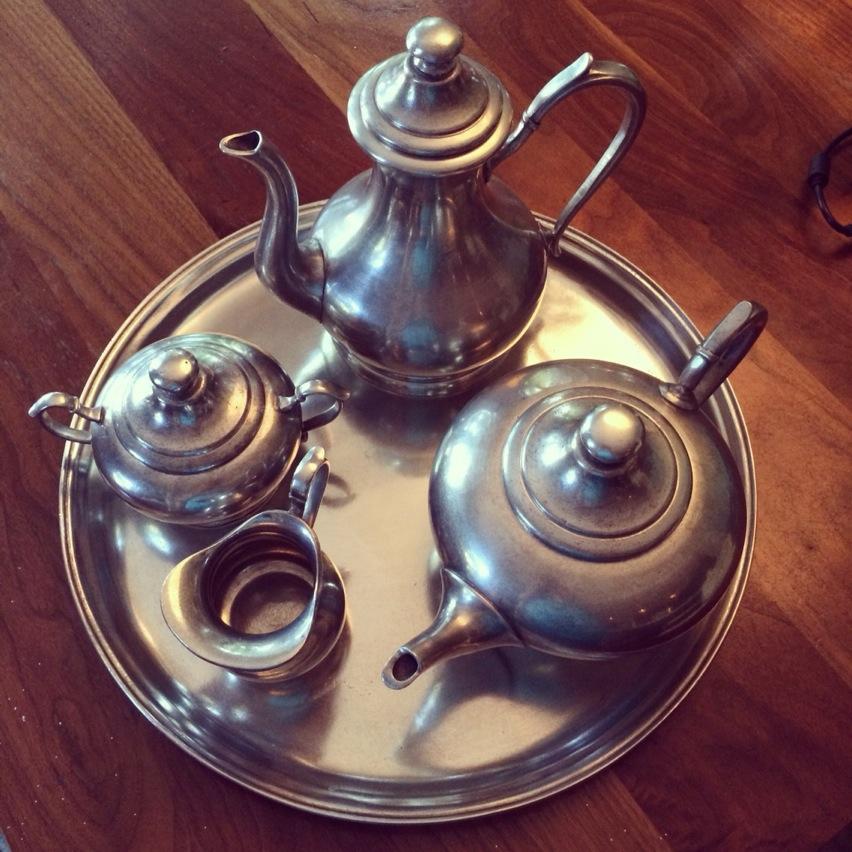
The Beauty of Pewter
Just gorgeous! Love pewter!
This past week my mother, brother, husband and I flew to her home in Colorado and went through the entire house and basement to categorize things that she wanted to bring back to California with her and things she wanted to sell in an estate sale. We came across many wonderful heirlooms that her mother and grandmother had passed on to her. My mom knows I am a big fan of pewter (as was her mom) so she gave me this wonderful Pewter coffee and tea set that her mother used. I’m not sure what it is about pewter, but I have loved it since I can remember. It reminds me of the ancient times and I can only image a clan sitting around a wooden table eating off of pewter plates. But since I didn’t know much about the history of pewter I did a little research and this is what I found out about this gorgeous material!
History of Pewter:
I was amazed to learn that Pewter was first used around the beginning of the Bronze Age in the Near East. The earliest piece of pewter found is from an Egyptian tomb from 1450 BC.
Pewter was used in the ancient world by the Egyptians and later the Romans, and came into extensive use in Europe from the Middle Ages until the various developments in pottery and glass-making during the 18th and 19th centuries. Pewter was also used around East Asia. Although some items still exist, Ancient Roman pewter is rare.
“Unlidded” mugs and lidded tankards may be the most familiar pewter artifacts from the late 17th and 18th centuries, although the metal was also used for many other items including porringers, plates, dishes, basins, spoons, measures, flagons, communion cups, teapots, sugar bowls, beer steins, and cream jugs.
Apparently pewter could only be found on the tables of the wealthy during the Middle Ages but eventually found its way into taverns and cottages. By the 15th century, pewter had replaced items made of clay, leather and wood. The Worshipful Company of Pewterers was established in London in 1348, and this guild controlled everything surrounding the production and distribution of pewter. Its stringent regulations gave English pewter the reputation of being the finest in the world.
In the early 19th century, changes in fashion caused a decline in the use of pewter flatware. At the same time, production increased of both cast and spun pewter tea sets, whale-oil lamps, candlesticks, and so on. Pewter trophies are awarded to 4th place winners in the United States Figure Skating Championships. (Source: Wikipedia).

Photo found on Seven Trees Farm
Pewter in America:
England regularly shipped pewter pieces to America, but English trade laws prohibited the export of tin to America, which meant that pewterers in Colonial America were restricted to melting down and recasting old pieces rather than creating their own. However, this also meant that American pewterers could sell their pieces for lower prices than the new imported English pieces. Pewter was primarily a luxury item in Colonial America, but colonists arriving from the 1630s onward brought it with them. There were at least five active pewterers in the Massachusetts Bay Colony in 1640, all of whom had trained in England under members of the Worshipful Company of Pewterers. (Source: ehow.com). I think that is why pewter is used in early American décor because of it’s association with colonial America.
Interesting Facts
During the American Revolution, many pewter pieces were surrendered to smelters to be melted down and made into musket balls.
Pewter was already regarded as something of an antiquity in 1839, when an old pewter beaker became the first recorded donation to the New Hampshire Historical Society.
While pewter reached its peak in the 17th century, some of the greatest works of art from the Art Nouveau and the Arts and Crafts period of the late 1800s to early 1900s were done in pewter. (Source: ehow.com).
For me, I love hearing the back story of how my grandmother would go out almost every weekend on the hunt for pewter at antique shops and estate sales. My mom said she would bring home the pieces and tap them with a small hammer to get any dents out. She loved pewter and I share this fascination with this metal as well! I plan to enjoy this set for years to come!
What is one of your favorite heirlooms passed down?
0


